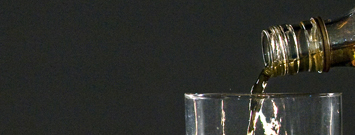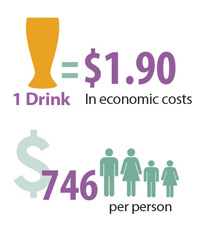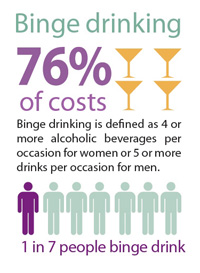Excessive Drinking Costs U.S. $223.5 Billion
 A new study finds that excessive alcohol consumption cost the United States $223.5 billion in 2006, or about $1.90 per drink. By implementing effective community-based prevention strategies, we can reduce excessive alcohol consumption and its costs.
A new study finds that excessive alcohol consumption cost the United States $223.5 billion in 2006, or about $1.90 per drink. By implementing effective community-based prevention strategies, we can reduce excessive alcohol consumption and its costs.
Excessive alcohol consumption is known to kill about 79,000 people in the United States each year, but a new study released by the CDC and The Lewin Group shows that it also has a huge impact on our wallets as well.
 The cost of excessive alcohol consumption in the United States reached $223.5 billion in 2006 or about $1.90 per drink. Almost three-quarters of these costs were due to binge drinking. Binge drinking is defined as consuming four or more alcoholic beverages per occasion for women or five or more drinks per occasion for men, and is the most common form of excessive alcohol consumption in the United States.
The cost of excessive alcohol consumption in the United States reached $223.5 billion in 2006 or about $1.90 per drink. Almost three-quarters of these costs were due to binge drinking. Binge drinking is defined as consuming four or more alcoholic beverages per occasion for women or five or more drinks per occasion for men, and is the most common form of excessive alcohol consumption in the United States.
The researchers found that the cost of excessive drinking was quite far-reaching, reflecting the effect this dangerous behavior has on many aspects of the drinker’s life and on the lives of those around them. The costs largely resulted from losses in workplace productivity (72% of the total cost), health care expenses for problems caused by excessive drinking (11% of total), law enforcement and other criminal justice expenses related to excessive alcohol consumption (9% of total), and motor vehicle crash costs from impaired driving (6% of the total).
The study analyzed national data from multiple sources to estimate the costs due to excessive drinking in 2006, the most recent year for which data were available. The study did not consider a number of other costs such as those because of pain and suffering among either the excessive drinker or others that were affected by their drinking, and thus may be an underestimate. Nevertheless, the researchers estimated that excessive drinking cost $746 for every man, woman, and child in the United States. in 2006.
 What You Need to Know About Binge Drinking
What You Need to Know About Binge Drinking
- Binge drinking is reported by about 15% of U.S. adults.
- Binge drinking is most common among men, 18- to 34-year-olds, whites, and people with household incomes of $75,000 or more.
- Most binge drinkers are not alcohol dependent.
How Can We Prevent Excessive Alcohol Consumption and Reduce Its Economic Costs?
There are many evidence-based strategies that communities can use to prevent excessive drinking, including the following:
- Increasing alcohol excise taxes.
- Reducing alcohol outlet density.
- Reducing the days and hours of alcohol sales.
- Holding alcohol retailers liable for injuries or damage done by their intoxicated or underage customers.
By implementing these evidence-based strategies, we can reduce excessive alcohol consumption and the many health and social costs related to it.
More Information
- Learn more about effective strategies communities can use to prevent excessive drinking and its costs.
- Find tools and resources related to the surveillance and prevention of excessive alcohol consumption and its costs.
- Article: Economic Costs of Excessive Alcohol consumption in the U.S., 2006.
- Binge Drinking Vital Signs Report
- Binge Drinking Fact Sheet
- Binge Drinking Video
- Binge Drinking MMWR
- CDC Alcohol and Public Health Program
- The High Price of Excessive Alcohol Consumption [PODCAST - 01:27 minutes]
CDC works 24/7 saving lives and protecting people from health threats to have a more secure nation. A US federal agency, CDC helps make the healthy choice the easy choice by putting science and prevention into action. CDC works to help people live longer, healthier and more productive lives.
Get email updates
To receive email updates about this page, enter your email address:
Contact Us:
- Centers for Disease Control and Prevention
1600 Clifton Rd
Atlanta, GA 30333 - 800-CDC-INFO
(800-232-4636)
TTY: (888) 232-6348 - cdcinfo@cdc.gov



